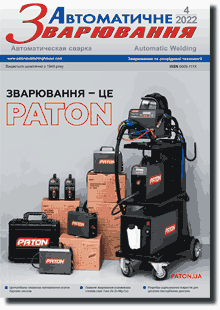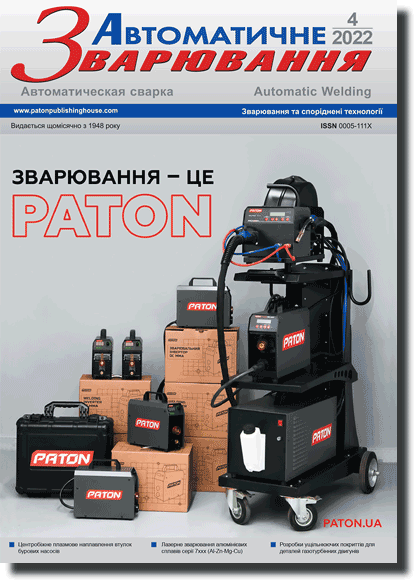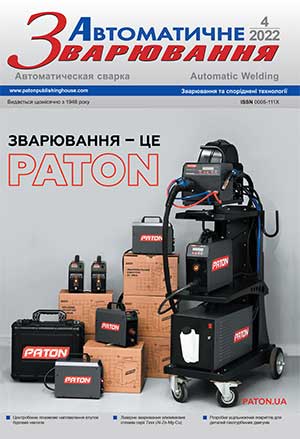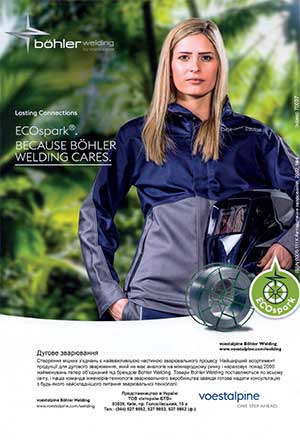| 2022 №04 (06) |
DOI of Article 10.37434/as2022.04.07 |
2022 №04 (01) |

"Avtomatychne Zvaryuvannya" (Automatic Welding), #4, 2022, pp. 50-53
Chemical welding of nanocomposites based on epoxy resin and oxidized graphene
A.V. Vashchuk, S.I. Motrunich, V.L. Demchenko, M.V. Iurzhenko
E.O. Paton Electric Welding Institute of the NAS of Ukraine. 11 Kazymyr Malevych Str., 03150, Kyiv, Ukraine. E-mail: office@paton.kiev.ua
In the work, the technology of chemical welding of polymer nanocomposites based on epoxy resins and oxidized graphene was developed. Overlapped welding of film materials with a thickness of 0.5 mm was carried out in the conditions of isothermal heating over 150 °C and under the pressure of the restrictive plate. The choice of effective welding conditions was made on the basis of changes in welding time. It is shown that strength of welded joints grows with an increase in welding time from 30 to 60 min. The chemical structure of welded joints material was examined by the Fourier-transform infrared spectroscopy. The peculiarities of the structural organization of nanocomposite films and their welded joints were investigated by the method of wide-angle X-ray scattering. 8 Ref., 1 Tabl., 5 Fig.
Keywords: epoxy nanocomposites, oxidized graphene, vitremers, welded joints, chemical welding
Received: 30.03.2022
References
1. Huang, X., Zeng, Z.Y., Fan, Z.X. et al. (2012) Graphenebased electrodes. Advanced Materials, 24 (45), 5979-6004. https://doi.org/10.1002/adma.2012015872. Gorelov, B.M., Gorb, A.M., Polovina, O.I. (2016) Nanosistemi, Nanomateriali, Nanotehnologii, 14, 4, 527.
3. Montarnal, D., Capelot, M., Tournilhac, F., Leibler, L. (2011) Silica-like malleable materials from permanent organic networks. Science, 334 (6058), 965-968. https://doi.org/10.1126/science.1212648
4. Avramova, N. (1999) High-performance laminates through chemical welding of thin liquid crystalline polymer films. Polymers for Advanced Technologies, 10, 229-236. https://doi.org/10.1002/(SICI)1099-1581(199904)10:4<229::AID-PAT866>3.0.CO;2-N
5. Shi, Q., Yu, K., Dunn, M.L. et al. (2016) Solvent assisted pressure-free surface welding and reprocessing of malleable epoxy polymers. Macromolecules, 49 (15), 5527-5537. https://doi.org/10.1021/acs.macromol.6b00858
6. Liu, H., Zhang, H., Wang, H. et al. (2019) Weldable, malleable and programmable epoxy vitrimers with high mechanical properties and water insensitivity. Chemical Engineering Journal, 368, 61-70. https://doi.org/10.1016/j.cej.2019.02.177
7. Wu, J., Yu, X., Zhang, H. et al. (2020) Fully biobased vitrimers from glycyrrhizic acid and soybean oil for self-healing, shape memory, weldable and recyclable materials. ACS Sustainable Chemistry & Engineering, 8 (16), 6479-6487. https://doi.org/10.1021/acssuschemeng.0c01047
8. Jurowska, A., Jurowski K. (2015) Vitrimers - the miracle polymer materials combining the properties of glass and plastic. Chemik, 69 (7), 389-394.
Advertising in this issue:
The cost of subscription/purchase order journals or individual articles
| Journal/Currency | Annual Set | 1 issue printed |
1 issue |
one article |
| TPWJ/USD | 384 $ | 32 $ | 26 $ | 13 $ |
| TPWJ/EUR | 348 € | 29 € | 24 € | 12 € |
| TPWJ/UAH | 7200 UAH | 600 UAH | 600 UAH | 280 UAH |
| AS/UAH | 1800 UAH | 300 UAH | 300 UAH | 150 UAH |
| AS/USD | 192 $ | 32 $ | 26 $ | 13 $ |
| AS/EUR | 180 € | 30 € | 25 € | 12 € |
| SEM/UAH | 1200 UAH | 300 UAH | 300 UAH | 150 UAH |
| SEM/USD | 128 $ | 32 $ | 26 $ | 13 $ |
| SEM/EUR | 120 € | 30 € | 25 € | 12 € |
| TDNK/UAH | 1200 UAH | 300 UAH | 300 UAH | 150 UAH |
| TDNK/USD | 128 $ | 32 $ | 26 $ | 13 $ |
| TDNK/EUR | 120 € | 30 € | 25 € | 15 € |
AS = «Automatic Welding» - 6 issues per year;
TPWJ = «PATON WELDING JOURNAL» - 12 issues per year;
SEM = «Electrometallurgy Today» - 4 issues per year;
TDNK = «Technical Diagnostics and Non-Destructive Testing» - 4 issues per year.









